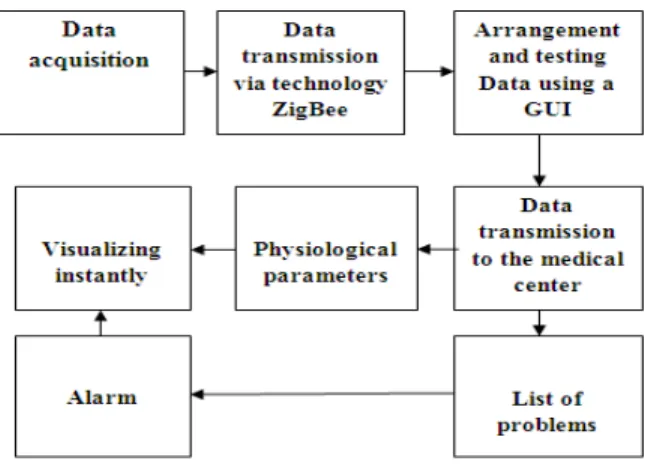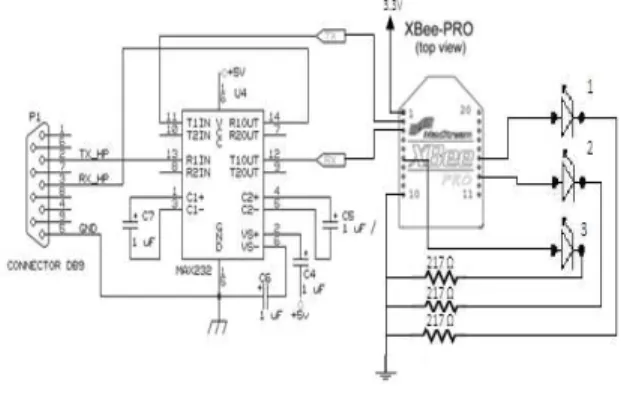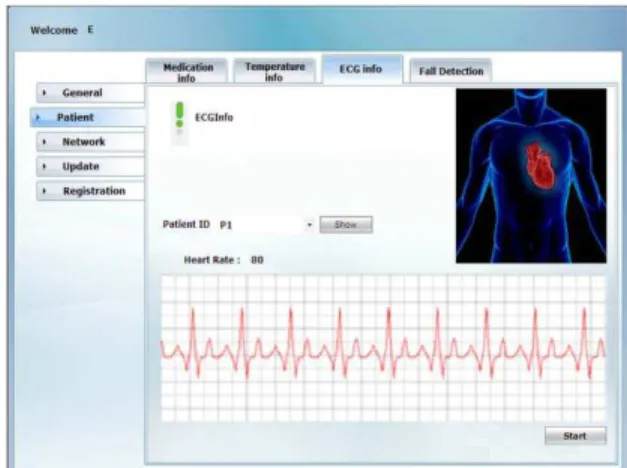www.IJCSI.org 126
Health Smart Home
Ahmad CHOUKEIR 1, Batoul FNEISH 1, Nour ZAAROUR 2,Walid FAHS 1, Mohammad AYACHE 2 1
Department of Computer and Communication, Islamic University of Lebanon, Faculty of Engineering Khaldeh, Lebanon
2
Department of Biomedical, Islamic University of Lebanon Faculty of Engineering Khaldeh, Lebanon
Abstract
We present in this paper a study and an experimental medical tele-surveillance system for maintaining patients at home. The aim of this paper is to demonstrate how combining many kinds of technologies starting with sensors connected to the patient then using wireless technology (ZigBee) to transmit information and finally analysis and detection of critical situation such as falls, ECG problems, hypothermia hyperthermia by using a GUI created to fulfill these missions. Many physiological parameters can be studied but we tended in our project to study ECG signal, heart rate, temperature of the patient, fall detection and medication reminder.
Results obtained allow the user to visualize online the parameters and to detect any problem that occurs, so by using this system we can observe the status of the patient during his normal life at his home.
Keywords Sensors, network, Telemedicine, Smart Home,
VB.net.
1.
Introduction
The term smart home [1, 2] has been used for more than a decade to introduce the concept of networking devices and equipment in the house.
The demographic trends of the advanced countries go towards the development of an older population so Health Smart Homes represent one of the most promising ways of development of telemedicine.
The aim of Smart Homes is the earlier detection and treatment of diseases. This need is due to many reasons such as economical reasons because earlier detection and treatment of diseases can be the solution to decrease the high costs, medical reasons (the most important) to monitor remotely the status of the patient living alone to detect possible deterioration in his health status, and
personal reasons because the ability of the “smart home” to measure medical data, and send it to the medical center through a network , makes it possible to lengthen the independent living at home.
The diagram described below aims to show how Health Smart Home contributes to increase the quality of life of patients and how telemedicine allows helping diagnostics of diseases without retardation to detect the minimal deterioration in patient’s status
.
Fig. 1: Bloc diagram
2.
Materials and Methods
2.1.The chain of information and communication
2.2.This paper shows different steps followed to achieve
this project.
www.IJCSI.org 127 - Sensors level (Level 1): the perception level of physical
events by means of sensors.
- Transmission level (Level 2): the level of information’s
distribution.
- Software level (Level 3): the level of communication
software used in the project.
- Network level (Level 4): the level of sharing data
concerning the system between the Smart Home and the Medical Center.
-
Human level (Level 5): we define at that level a seriesof typical profiles of people involved in the medical tele-observation
.
2.3.Description of levels
Level 1: Sensors level
Many physiological parameters can be studied to observe the status of the patient
Electrocardiogram (ECG) which represents measures and
records the electrical activity of the heart in exquisite detail. Interpretation of these details allows diagnosis of a wide range of heart conditions and computing the Heart Rate which is the number of heartbeats per unit of time - typically expressed as beats per minute (bpm) - which can vary as the body's need for oxygen changes, such as during exercise or sleep. The measurement of heart rate is used by medical professionals to assist in the diagnosis and tracking of medical conditions.
To achieve the acquisition of the signal ECG from the patient we made an electronic circuit to detect the ECG of the patient .This work is done by the implementation of the circuit
below.
Fig.2: ECG circuit
Temperature which represents an important parameter to
determine the case of the patient whether it’s a case of hypothermia, hyperthermia or normal case. This physiological parameter is measured by using the integrated
circuit LM35 with an amplifier and a simple calculation is made to know the temperature proportional to the voltage at the output of the circuit.
Equilibrium and fall in case of an elderly person which can
result in quite serious injuries because of his/her fragile bone structure. In-fact the detection of the fall as soon as possible can help to limit the negative consequences. To detect the fall of the patient we used a key fill at a determined level with mercury which is a metal. This key is placed on the hip of the patient in case if he falls the metal will close the circuit and a voltage of 5 volt will be obtained at the output of the circuit.
In addition to, the medication is designed to improve patient health, but it must be taken correctly and in time to be effective. So Health Smart Home is charged to remember the patient by his medication including all details (name, time, number of pills and duration).
Level 2: Transmission level
To transmit the information from the sensors to the computer at Patient Home we used the modules ZigBee to fulfill this mission.
Zigbee is a software-based protocol that sits on top of the 802.11 RF wireless devices standard similar to Bluetooth. Unlike Bluetooth, Zigbee is capable of forming large networks of nodes and boasts advanced features such as mesh networking, simple addressing structures, route detection, route repair, guaranteed delivery and low power operation modes. [3,4].
In this paper we will describe two circuits used to fulfill this job:
1‐ Emission circuit
1. 2- Receiving circuit
1. Emission circuit
This circuit is in the pocket carried by the patient and its mission is to transmit the data to the receiving circuit. The module ZigBee should be configured as an emitter.
www.IJCSI.org 128
Fig. 3: Emission circuit
2. Receiving circuit
This circuit is related to the computer of the patient to transmit serially the data. The module ZigBee should be configured as a receiver.
Fig.4 Receiving circuit
Level 3: Software level
Description of the application
In this level an application is created using Vb.net to accomplish many missions:
1. To get the information from the sensors (physiological
parameters).
2. To enter all data concerning a patient or an employee.
3. To ensure system security.
4. To give a level of access for each user.
5. To identify problems.
This application includes two types of modules.
Module A: This module is located at the patient's home and devoted to information acquisition, data recording, analysis, testing and filling a data base in case of problems.
This information is shared on the network.
Module B: this module is located at the patient’s home and at the medical center.
At the patient’s Home: the aim of the application in this case is to remember the patient by his medication and to give him the ability to visualize all details about his medications.
At the medical center: The main functions available through the GUI according to the user's access rights are: allowing the registration of new patients or members in medical staff to give them the authorization to have an access on the system with respect to their privilege, allowing to the doctors the prescription of the medications for a specific patient, write/display a report or a prescription, monitor sensors and display statistics allowing the visualization of all the
parameters ( ECG signal, heart rate, temperature of the patient and its description, the status of the patient (in case of fall or not)) .
In addition to, the application allows alerting the medical staff in case of problems or deterioration of the patient’s state
.
Data base
The application includes many data bases concerning all the information related to the patient and to the system (problems, registration, updating..).
The figure fig. 5 shows the data bases used by the GUI. The module A described fills the data base concerning the problems. Besides the module B fills the data bases concerning the patient and the medical staff, also this module uses the data bases to assure the security of the system and tells which computers on the system are using the application and the computers which can be alerted in case of problems.
Fig. 5: Data Base
Level 4: Network
www.IJCSI.org 129
Fig. 6: Sharing files and Mapping
Level 5 : Human level
The access to the system is allowed to authorized users only so in our project we define four user profiles: administrator, medical, partial and patient. One physical person may have one or several user profiles.
Table 1: Possible set up of access rights
Each access determines the behavior of the user’s application and that is used to assure a high level of security and confidentiality of the system.
3.
Results
The first result to mention is the realization of an operational information and Communication System-Health Smart Home demonstration system.
We realize all the electronic circuits described above. Also a GUI is created using VB.net with 3136 program lines and 45 functions.
We could observe the electrocardiogram online and calculate the heart rate each 60 seconds, in case if the heart rate
doesn’t belong to the normal range an alert will be activated in the medical center. (Figure 7)
Fig. 7: ECG information
The temperature is measured and tested if it belongs to the normal range and the result is visualized (figure 8).
Fig.8 Temperature Information
The fall of the patient is detected and a camera is turned on and a figure is taken (figure 9).
www.IJCSI.org 130 On the other hand forms are created in the application to
accomplish the mission of update system, registration, networking, prescription of the medication, and searching for the coordinates of an employee or a patient.
The most important mission achieved by the application is alerting the medical staff in case of any problem and this is accomplished by a “Problem Form” which determines all the details of the problem
.
4.
Conclusion and future work
The real use of this system in the everyday life of a person meets a certain number of issues at the following general levels: moral, ethical and medico legal, socio-medical and organizational, economical, technical and of quality assurance. [5, 6, 7].
It was our first step in telemedicine and all this work has been done in a short time (four months including researches, planning, programming, and implementation and getting results in real time).
This was a simple base which can be developed by using many sensors to reach an “Ubiquitous” acquisition of the data to observe the detailed status of the patient.
Acknowledgment
We are grateful to the direction of the faculty of Engineering at the Islamic University in Lebanon. This project is done in the laboratory of the faculty.
References
[1] Brooks RA. The Intelligent Room Project. In: Marsh JP, Nehaniv CL, Gorayska B, editors. Proc. CT'98 : 2nd Int Conf Cognitive Technology. Los Alamitos, California: IEEE Computer Soc; 1997. pp. 271-277.
[2] Tang P. and T. Venables, 'Smart' homes and telecare for independent living, J Telemed Telecare2000: 6(1) pp. 8- 14. [3] Drew Gislason, Zigbee Wireless networking, Elsevier, 2008.
[4] Ata Elahi, Adam Gschwender, Zigbee Wireless Sensor
and control Network, ISBN 13: 9780137134854.
[5] An Experimental Health Smart Home and Its Distributed Internet-based Information and Communication System: First Steps of a Research Project Vincent Rialle, Norbert Noury, Thierry Hervé Laboratory TIMC-IMAG UMR CNRS 5525, μISFV team, Grenoble, France
[6] Fisk MJ. Telecare equipment in the home. Issues of intrusiveness and control. J Telemed Telecare 1997: 3(Suppl 1) pp. 30-32.
[7] McShane R., T. Hope and J. Wilkinson, Tracking patients who wander: ethics and technology, Lancet 1994: 343 pp. 1274


